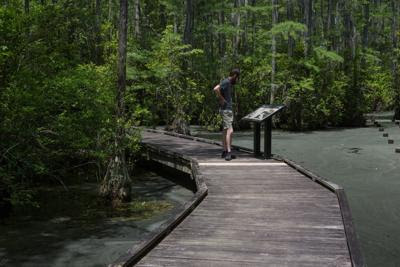Editorial: South Carolina needs to get serious about new wetlands protection
- BY THE EDITORIAL STAFF
- Jul 29, 2023

This Carolina Bay is protected from development because it is the feature of Woods Bay State Park, but other Carolina Bays face an uncertain future because of shifting laws and regulations regarding isolated wetlands. Provided
Heidi StoneTwo significant recent events should work together to push the issue of protecting South Carolina’s isolated wetlands toward the top of lawmakers’ agendas for the coming year.
The first is the U.S. Supreme Court ruling in Sackett v. Environmental Protection Agency that held that only wetlands connected to other surface waters are regulated under the federal Clean Water Act. That limits federal jurisdiction to areas with, in the ruling’s words, a “continuous surface water connection with a larger body of water.” While many in the environmental community have expressed concerns that the ruling — and the diminution of federal protection — will endanger more wetlands with development, that does not have to be the case.
States are free to step in and enact their own regulations to protect isolated wetlands, and we would urge S.C. lawmakers to do just that. Our state’s coastal plain has several Carolina Bays, isolated wetland features now apparently unprotected by the Clean Water Act. These unique and somewhat mysterious areas offer important habitat to unique birds and plants, and they also act as filters, improving regional water quality. One has been made into Woods Bay State Park in southwestern Florence County.
But Carolina Bays are far from the only sort of isolated wetlands left unprotected by the high court’s May ruling, which arrived at a moment when we are appreciating wetlands even more, not only for their contribution to biodiversity and water quality but also for their ability to limit flooding.
That’s where the other major development comes in: the June 29 release of South Carolina’s Strategic Statewide Resilience and Risk Reduction Plan, which recognizes the new realities regarding both flood-prone landscapes and our shifting regulatory landscape.
“The (Sackett) decision puts some of South Carolina’s unique isolated wetlands features such as Carolina Bays at risk of unregulated development,” the plan says in one of its recommendations: “Isolated wetlands, such as Carolina Bays, offer habitat and flood mitigation in South Carolina. A majority are in the coastal zone where populations are increasing and therefore at an increased risk of loss to development. New state legislation should be enacted to regulate the alteration of these unique systems to reduce the potential loss of function.”
This might not be the most significant of the plan’s many recommendations, but it could represent some of the lower-hanging fruit. In a similar vein, the plan also recommends maintaining natural protection against flooding by prioritizing conservation work in areas known to help with absorbing heavy rainfalls and swollen rivers. The plan notes that the South Carolina Office of Resilience has public and private databases “identifying areas where floodwaters are expected, where wetlands can help absorb excess water, and those areas where water is most likely to infiltrate the ground as opposed to creating excess runoff. Protecting these areas may help attenuate the impact that future development has.”
While conservation work is vital for many reasons, an increased focus on protecting landscapes, particularly wetlands, will help lessen future flood risk.
Many environmentalists fear the new Supreme Court precedent will lead to further damaging decisions because many believe the notion of an isolated wetland is an oxymoron, since we know relatively little about how water is connected underground. Also, some lands are wet only certain times of the year, and it’s unclear which ones still will face review under the Clean Water Act, the goal of which is no net loss of our nation’s wetlands.
We share their concerns and urge state lawmakers to address them by acting next year to adopt new state-level protections. Many lawmakers bristle at federal intervention in areas where they believe state government could handle things better; this wetlands issue represents a chance for them to prove we can do better. But we’ll only succeed if they act.

No comments:
Post a Comment